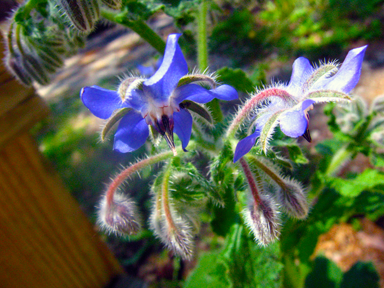Heirloom Information, Companion Planting
 Along with heirloom seeds, the knowledge about how to grow them has been passed down from generation to generation also. Organic gardening is what I do, and it's what I encourage you to do also. Take a cue from nature, nature is organic.
Along with heirloom seeds, the knowledge about how to grow them has been passed down from generation to generation also. Organic gardening is what I do, and it's what I encourage you to do also. Take a cue from nature, nature is organic.
When you create an garden, you're creating an environment for life of more than plants. You're creating a source of life for various creatures that exist in nature too. This is good. It's what you want to do. It's healthy and sustainable. Achieving the right balance is a challenge, but it's possible with some planning based in solid information.
While there are some creatures that will be drawn to your garden that you don't want, rabbits, deer and woodchucks for example, the fact that they are drawn to something you create to sustain their life tells you that your doing something right.
You do want to attract beneficial, whether they are pollinators, birds, or frogs, companion planting is one way to achieve this. Your garden is a abundant source of life concentrated in small area. That's why companion planting is important.
Here are a few examples of why you should companion plant.
- The legendary Native American Three Sisters, consists of corn, vining beans and squash. The corn provides a pole for the vining beans to grow up, so no poles are needs. The squash with it's broad leaves provide shade to soil which helps retain moisture and discourages weeds, and the prickly nature of squash plants deters some pests. Additionally the nutrients from these plants compliment each other. When cooked together, they form a perfect protein.
- By planting different varieties of plants together you lessen the risk of an infestation of predator bugs. If you have a concentration of one variety of vegetable in a small area, you're offering up a all you can eat buffet for some bugs. If you scatter plants around, it's more of a scarp here and there instead. Companion plant some marigolds with the scattered planting, which have a scent that repels some pests, you have a scrap that smell rotten.With this type of companion planting you are creating a sustainable environment for vegetable plants and marigolds which attracts and sustains beneficial pollinators, and reducing the need for toxic chemical insecticides.
- Companion plants can serve as traps crops also. If you know have a common pest in the area where you garden that your crops attract, you can plant a companion plants as trap for the pests. Plant a concentrated area of the companion plant as a trap for the pest. Given the choice between an concentrated area of food, and a scattered area mention above, bugs will likely choose the concentrated area. Once they are concentrated, the pests are easier to pick off because they are in a concentrated area.
There are many other benefits to companion planting, and I've added a Companion Planting page that has three links to more information, including a pdf that you can download excerpted from Companion Planting, a book from Rodale’s Successful Organic Gardening series.
Just as some plants do well planted together, some plants don't. You can go here for a good chart of what not to plant together. There are more benefits than there are drawbacks so most of the information out there reflect that.
The bottom line is nature knows best, and think about any walk in a meadow, or woods that you have taken. That's the best example of the power and benefit of companion planting. Created by nature to sustain itself, over generations of time. Learning from that is the best source of heirloom information.
